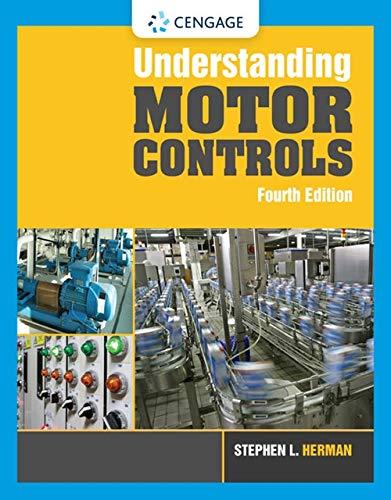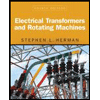![MindTap for Herman's Understanding Motor Controls, 4th Edition [Instant Access], 2 terms](https://s3.amazonaws.com/compass-isbn-assets/textbook_empty_images/large_textbook_empty.svg)
MindTap for Herman's Understanding Motor Controls, 4th Edition [Instant Access], 2 terms
4th Edition
ISBN: 9781337798754
Author: Herman; Stephen L.
Publisher: Cengage Learning US
expand_more
expand_more
format_list_bulleted
Concept explainers
Question
Chapter 22, Problem 1RQ
To determine
The advantage of the point-to-point method of connecting circuit components.
Expert Solution & Answer
Explanation of Solution
The point-to-point connection method is a method used for the installation of components in a control circuit. The wires in the control circuit are given a wire number, but not for the wires in the load circuit. Dashed lines are used to represent the components located in MCC (motor control center). The components are connected from one point to another based on the proximity of the components.
The advantages of the point-to-point method of connecting components are as follows:
- Saves the mount of wire required by reducing the wastage of wire.
- The connections inside and outside the motor control center can be distinguished.
- The wire tags and the real terminal designations are shown.
- It is easy to troubleshoot and service.
- It is easy to identify the components.
Want to see more full solutions like this?
Subscribe now to access step-by-step solutions to millions of textbook problems written by subject matter experts!
Students have asked these similar questions
Q1.Given the unity feedback system with a forward path transfer function,
G(s) =
=
K
(s+1)(s+2)(s+6)
. Do the following:
(a) Draw the root locus
(b) Find the gain, K, and natural frequency for a damping ratio 0.5.
(c) Find the range or value of gain, K for
i. overdamped ii. critically damped iii. Undamped iv. underdamped
Q. 1: The partial Routh array of a unity feedback system is given below.
S6
1
Adel
8
S5
1
S4
2
Bash
6
-4
0
C
0
How many roots does it have in the right half plane? Comment on the
stability of the system. Determine the characteristic equation of the system.
Q.2: Find the values of Ki and K2 for the system shown in the figure below
when Mp=0.25% and tp= 4 sec. assume unit step input.
R(S)
K₁
C(S)
1+ K₂S
Temperature
EXAMPLE 1: A diesel engine is fitted with a turbocharger,
which comprises a radial compressor driven by a radial
exhaust gas turbine. The air is drawn into the compressor at
a pressure of 0.95 bar and at a temperature of 15°C, and
is delivered to the engine at a pressure of 2.0 bar. The
engine is operating on a gravimetric air/fuel ratio of 18: 1,
and the exhaust leaves the engine at a temperature of
600°C and at a pressure of 1.8 bar; the turbine exhausts at
1.05 bar. The isentropic efficiencies of the compressor and T(K)
turbine are 70 per cent and 80 per cent, respectively.
Calculate (i) the temperature of the air leaving the
compressor (ii) the temperature of the gases leaving the
turbine (iii) the mechanical power loss in the turbocharger
expressed as a percentage of the power generated in the
turbine. Using the values of : Cpair = 1.01 kJ/kg K, Vair = 1.4
Cpex = 1.15 kJ/kg K, Yex = 1.33
and
2s
с
P2
Engine
P3
W
W₁ = mexpex (T3-TA)
At
W₁ = mair Cpex
(T2-T₁)
4
P4…
Chapter 22 Solutions
MindTap for Herman's Understanding Motor Controls, 4th Edition [Instant Access], 2 terms
Ch. 22 - Prob. 1RQCh. 22 - When connecting a control system, what should be...Ch. 22 - What should be done to each component to help...Ch. 22 - What is the disadvantage of wiring components to a...Ch. 22 - What is the main advantage of making connections...Ch. 22 - Refer to the circuit shown in Figure 221. Should...Ch. 22 - What does the dashed line between the two float...
Knowledge Booster
Learn more about
Need a deep-dive on the concept behind this application? Look no further. Learn more about this topic, mechanical-engineering and related others by exploring similar questions and additional content below.Similar questions
- Problem 8.28 Part A 10 of 10 ■Review The uniform crate resting on the dolly has a mass of 530 kg and mass center at G as shown in (Figure 1). If the front casters contact a high step, and the coefficient of static friction between the crate and the dolly is μs = 0.45, determine the greatest force P that can be applied without causing motion of the crate. The dolly does not move. Express your answer to three significant figures and include the appropriate units. Figure -0.5 m- 0.6 m 0.3 m 0.1 m B 0.4 m 0.3 m > ☐ P = 1210 Submit о ΜΑ N Previous Answers Request Answer × Incorrect; Try Again 1 of 1 < Return to Assignment Provide Feedback ?arrow_forwardQ1: For the system shown in Fig. 6.7, the following data are applicable P1 = 7 bar Q=0.002 m3/sec Pipe: total length 15m and ID 38mm Oil: SG-0.90 and kinematic viscosity (v-0.0001 m2/s) Solve for P2 in units of bars. Motor OH Pump Breather P1 Pipe length = 3m 90' elbow ☐ 38 mm (ID) Pipe length = 2m P2 Load force Pipe length 4 m = Pipe length=6m 90' elbowarrow_forwardusing the three moment theorem please find the moments about B, C and Darrow_forward
- A viscous fluid flows in a 0.10-m-diameter pipe such that its velocity measured 0.010 m away from the pipe wall is 0.9 m/s. If the flow is laminar, determine (a) the centerline velocity and (b) the flowrate. (a) Vi (b) Q = i m/s × 103 m³/sarrow_forwardThis is an old exam review question please help.arrow_forwardThis is an old exam review problem. Please helparrow_forward
- This is an exam review problem please helparrow_forwardThis is an old exam review problem. Please helparrow_forward3. The volumetric flow rate of air through a duct transition of the type shown in Table 12-9b (rectangular with two parallel sides) is 2 m3/s. The duct before the transition issquare, with a height of 50 cm. The expansion ratio across the transition is 4 (i.e., theduct area after the transition is 4 times greater than the duct area before the transition).a) Determine the pressure loss (in Pa) across the transition if the exit from the duct isabrupt (i.e., the diverging angle of the transition is 180º).b) Determine the percentage reduction in pressure loss for a transition diverging angleof 20º compared to the one in part (a).c) The head HVAC engineer requires the pressure loss across the transition to bereduced to less than 50% of the pressure loss for an abrupt exit (i.e., the case in part(a)), and suggests a transition diverging angle of 45º. Will this new diverging angleachieve the required reduction in pressure loss? Justify your answer.d) For a transition diverging angle of 90º,…arrow_forward
- The wheel shown is made of 2 rings and 8 rods. The otter ring weighs 100 lbs, the inner ring weighs 15 lbs,and each of the rods weighs 20 lbs. Find the moment of inertia of the wheel about an axis that comes directlyout of the page through point A.arrow_forwardMini project You are an engineer working for a power systems company responsible for ensuring grid stability. Your team has recently observed low-frequency oscillations in the system following disturbances such as load changes, faults, and switching operations. These oscillations have led to voltage instability, frequency deviations, and, in severe cases, system blackouts. A task force has been formed to address this issue, and you have been assigned a critical role in developing a damping control strategy. Your objective is to analyze system performance, propose engineering solutions, and compare the effects of different damping approaches. Answer the following questions 1. Identify the Engineering Problem: - What is the fundamental issue affecting power grid stability? - How do low-frequency oscillations impact the system's reliability? - What parameters indicate system instability? 2. Assess the Current Status Using Equations and Calculations: - Given the characteristic roots of the…arrow_forwardH.W 4: The beam shown below is subjected to the distributed loading of w=120 kN/m. Determine the principal stresses in the beam at point P, which lies at the top of the web. Neglect the size of the fillets and stress concentrations at this point. I=67.4×10-6 m4. 15 mm w=120 kN/m B 0.3 m 2 200 mm A 10 rim 15 mm 175 mmarrow_forward
arrow_back_ios
SEE MORE QUESTIONS
arrow_forward_ios
Recommended textbooks for you
 Understanding Motor ControlsMechanical EngineeringISBN:9781337798686Author:Stephen L. HermanPublisher:Delmar Cengage Learning
Understanding Motor ControlsMechanical EngineeringISBN:9781337798686Author:Stephen L. HermanPublisher:Delmar Cengage Learning Refrigeration and Air Conditioning Technology (Mi...Mechanical EngineeringISBN:9781305578296Author:John Tomczyk, Eugene Silberstein, Bill Whitman, Bill JohnsonPublisher:Cengage Learning
Refrigeration and Air Conditioning Technology (Mi...Mechanical EngineeringISBN:9781305578296Author:John Tomczyk, Eugene Silberstein, Bill Whitman, Bill JohnsonPublisher:Cengage Learning Electrical Transformers and Rotating MachinesMechanical EngineeringISBN:9781305494817Author:Stephen L. HermanPublisher:Cengage Learning
Electrical Transformers and Rotating MachinesMechanical EngineeringISBN:9781305494817Author:Stephen L. HermanPublisher:Cengage Learning Automotive Technology: A Systems Approach (MindTa...Mechanical EngineeringISBN:9781133612315Author:Jack Erjavec, Rob ThompsonPublisher:Cengage Learning
Automotive Technology: A Systems Approach (MindTa...Mechanical EngineeringISBN:9781133612315Author:Jack Erjavec, Rob ThompsonPublisher:Cengage Learning Precision Machining Technology (MindTap Course Li...Mechanical EngineeringISBN:9781285444543Author:Peter J. Hoffman, Eric S. Hopewell, Brian JanesPublisher:Cengage Learning
Precision Machining Technology (MindTap Course Li...Mechanical EngineeringISBN:9781285444543Author:Peter J. Hoffman, Eric S. Hopewell, Brian JanesPublisher:Cengage Learning

Understanding Motor Controls
Mechanical Engineering
ISBN:9781337798686
Author:Stephen L. Herman
Publisher:Delmar Cengage Learning

Refrigeration and Air Conditioning Technology (Mi...
Mechanical Engineering
ISBN:9781305578296
Author:John Tomczyk, Eugene Silberstein, Bill Whitman, Bill Johnson
Publisher:Cengage Learning

Electrical Transformers and Rotating Machines
Mechanical Engineering
ISBN:9781305494817
Author:Stephen L. Herman
Publisher:Cengage Learning

Automotive Technology: A Systems Approach (MindTa...
Mechanical Engineering
ISBN:9781133612315
Author:Jack Erjavec, Rob Thompson
Publisher:Cengage Learning

Precision Machining Technology (MindTap Course Li...
Mechanical Engineering
ISBN:9781285444543
Author:Peter J. Hoffman, Eric S. Hopewell, Brian Janes
Publisher:Cengage Learning